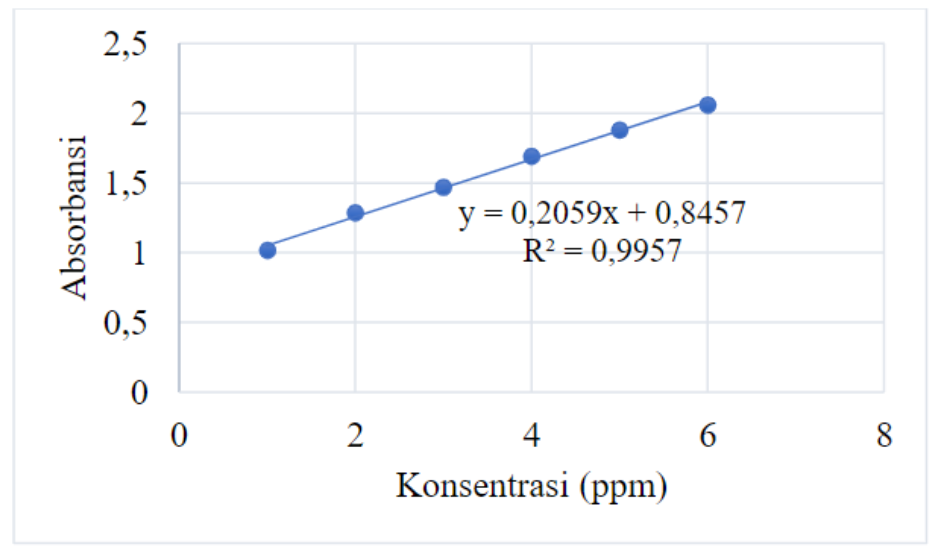Main Article Content
Abstract
Borax is a dangerous material if it is contained in food so its use is prohibited. Borax contained in wet noodles is used as a preservative to keep the noodles supple and durable. There are reports in several areas in Tangerang about the content of borax in food, but no research has been conducted in the Sepatan Market, Tangerang Regency. Identification of borax by qualitative test using flame test method and curcumin paper color test, while quantitative test using UV-Vis Spectrophotometry method with a wavelength of 536.40 nm. Two of the total samples tested using ultraviolet visible spectrophotometric instruments showed negative borax content when compared to the flame test and curcumin paper color test. Wet noodle samples sold at Pasar Sepatan, Tangerang Regency, showed a positive content of Borax at 85.71% of the total sample.
Keywords
Article Details

This work is licensed under a Creative Commons Attribution-NonCommercial 4.0 International License.
References
- Alfreda, E. (2019). Petugas Temukan Bahan Makanan Mengandung Boraks dan Formalin di Jakarta. Tribun Jakarta.com. 1–5.
- Asterina, A., Elmatris, E., & Endrinaldi, E. (2015). Identifikasi Dan Penentuan Kadar Boraks Pada Mie Basah Yang Beredar Dibeberapa Pasar Di Kota Padang. Majalah Kedokteran Andalas, 32(2).
- Young, J. A. (2001). Introducing Chemical Laboratory Information Profiles: CLIPs. Journal of Chemical Education, 78(4), 444.
- Menteri Kesehatan RI. (2012). Peraturan Menteri Kesehatan No 33 tahun 2012 tentang Bahan Tambahan Pangan. Indonesia.
- Muntikah, M. R. (2017). Ilmu Teknologi Pangan-Pusat Pendidikan Sumber Daya Manusia Kesehatan. Kementerian Kesehatan Republik Indonesia.
- NPIC. (2020). Boric Acid General Fact Sheet, Southern Medical Journal. doi: 10.1097/00007611-194201000-00014.
- Payu, M. (2014). Analisis Boraks pada Mie Basah yang Dijual di Kota Manado. PHARMACON, 3(2).
- Pemerintah Kota. (2021). dinkes-beri-edukasi-pentingnya-keamanan-pangan.pdf. Pekalongan. Available at: https://pekalongankota.go.id/ (Accessed: 22 March 2022).
- Prihhapso, Y. et al. (2020). Panduan Kalibrasi Spektrofometer UV-Vis. SNSU PK.F-,Direktorat Standar Nasional Satuan Ukuran Termoelektrik dan Kimia. SNSU PK.F-.Badan Standardisasi Nasional. Indonesia.
- Rohman, A., & Gandjar, I. G. (2007). Kimia Farmasi Analisis. Cetakan I. Penerbit Pustaka Pelajar, Yogyakarta.
- Rahmawarti, Fitri. (2011). Pengawetan makanan dan permasalahannya. 51–70. Yogyakarta: FT Busana.
- Reubun, Y. T. A., & Herdini, H. (2021). Analisis Boraks pada Mie Basah dan Mie Kering di Bekasi Utara dan Bekasi Timur dengan Spektrofotometri UV-Vis. Sainstech Farma, 14(1), 1-4.
- Rumanta, M., Iryani, K., & Ratnaningsih, A. (2016). Analisis Kandungan Boraks Pada Makanan: Studi Kasus Di Wilayah Kecamatan Pamulang, Tangerang Selatan. Jurnal Matematika Sains dan Teknologi, 17(1), 40-49.
- Safitri, J. M., Tiwow, G., Untu, S., & Kanter, J. (2019). Identifikasi Boraks Pada Mie Basah yang Beredar di Supermarket dan Pasar Tradisional di Kota Bitung. Biofarmasetikal Tropis, 2(1), 36-42.
- Suseno, D. (2019). Analisis Kualitatif dan Kuantitatif Kandungan Boraks Pada Bakso Menggunakan Kertas Turmerik, FT–IR Spektrometer dan Spektrofotometer Uv-Vis. Indonesia Journal of Halal, 2(1), 1.
- Tumbel, M. (2010). Analysis of Borax Content in Wet Noodles Circulating in Makassar City. Chemical Journal, 11(1), 57-64.
